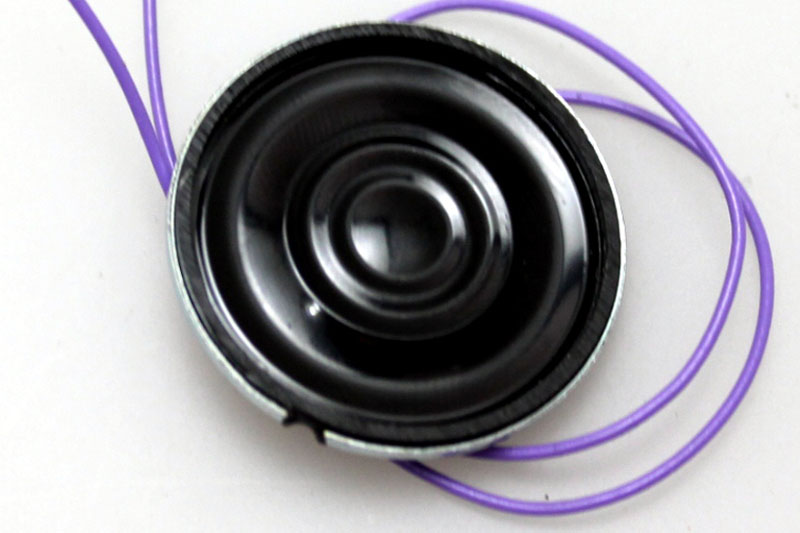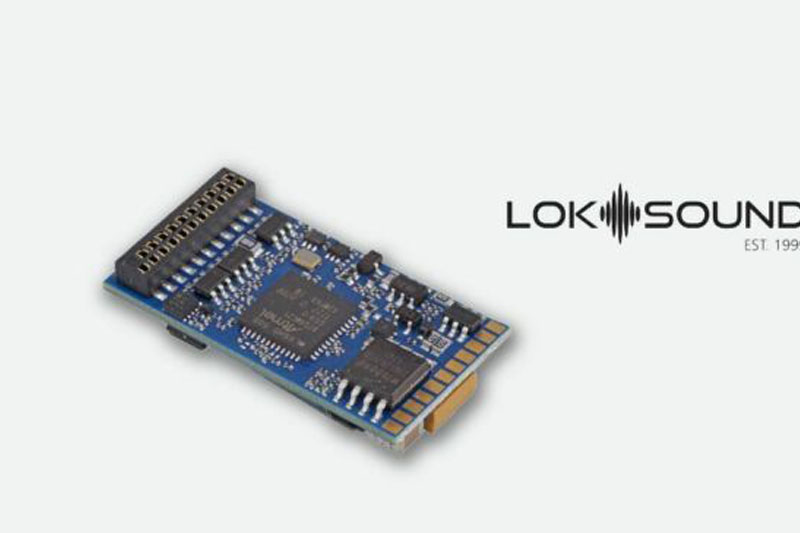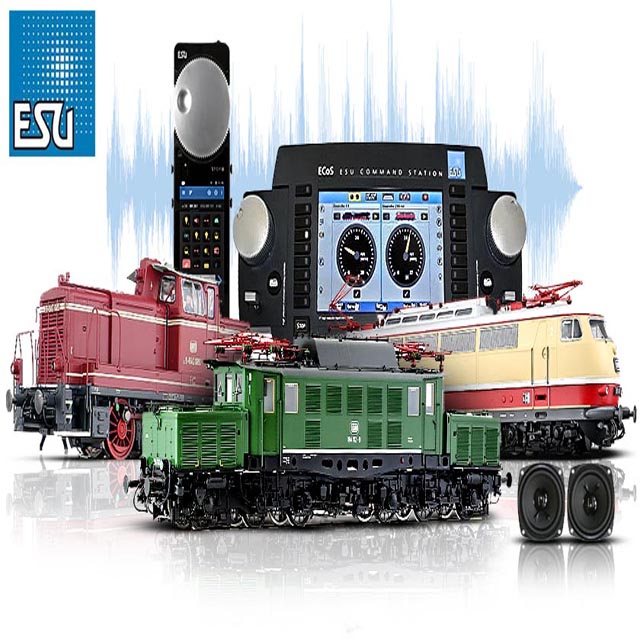From the Basic to the Complex!
Do you need just a basic plug and play decoder installed or maybe a more advanced hard-wired sound decoder? Have a building you want illuminated and controlled with DCC? Maybe looking to add realistic sounds to scenes via DCC. Or better yet, looking at using a Rasp berry Pi with JMRI to control your existing layout. Well I work with you and your budget to get that project back on track. DCC can add value to any model railroad. Let me help you bring your railroad into the new millennium.

DCC Programing
From testing an existing DCC unit or reprogramming the sounds to match an existing locomotive I got you covered. I use the ESU LokProgrammer or even JMRI to test, program and get that locomotive back in service and running on the mainline.

Sound Installation
Whether you need a speaker replaced, upgraded or added to your DCC Decoder I got you covered. Different locomotives require different speaker designs and sizes, there is no one size fits all here. Let me help take the guess work out and bring realism back to life.

DCC Installation
With an array of choices find the right board to fit your needs. Whether it be a simple plug & play unit to a more complex full DCC Install with sound, I’ll help take the guess work out and get your unit back on the rails and within budget.
history of DCC
DCC came out in the mid 1990's and around 2005 technology made sound a very practicable and affordable part of DCC. SoundTraxx got the ball rolling and then QSI stepped in supplying sound to BLI for their locomotives. In 2005 a number of sound players got into the act. MRC came out with a new line sound decoders for steam and diesel called “Brilliance”. Digitrax announced they were going to produce DCC sound decoders called “Tsunami” and in 2016 they introduced us to new Tsunami2 Digital Sound Decoders. ESU of Germany has been making sound decoders since 1999 and is now marketing them in the USA. The ESU line of decoders is called “LokSound” with their newest version called LokSound5. ESU is currently being factory installed in an array of manufactures including ScaleTrains and Kato.
The big advancement in sound decoders today is the ability to download sound files directly to decoder. What this means for the dealer is they only stock one DCC decoder and then download the locomotive sound file that the customer ordered. If the modeler has a programmer or is familiar with JMRI as well as a few other programs, they can change or modify the sounds in the decoder to match their requirements. A decoder that was programed for diesel sounds could be reprograming for a steam engine, which would be weird, but can be done. Also, some of these companies have included what we call “Easter Egg” files hidden that can be launched and are pretty funny.
Many of these sound files were created by recording locomotives that are in museums. However, newer models are recorded from operational locomotives and can give the modeler a more realist feel to their railroad.

NOT ALL SOUNDS ARE CREATED EQUAL
The sound that came out of the tiny speakers in our locomotives years ago, were tinny at best and were subject to a many variables. It started with how the sound was originally recorded. For example sound recorded with 24 bit will sound better than an 8 bit recording. The location of the microphone when recording can make a big difference. Plus the location of speaker(s) as well as the quality and quantity of the speaker(s) compared to older models makes a big different
Downloadable sounds can vary in quality and sound level from manufacture as well as site to site. I’ve downloaded different sound files and found some to be loud while others tend to be just barely audible. Sometimes you need to shop around different sites if you want to customize a locomotive to your individual needs. You also might find you need to have a little engineering knowledge in audio so you can further enhance the sounds for optimal playback. There is a fine line between great sound files and the space you have available on the individual decoder for storage.
MAKING ROOM FOR DCC AND SOUND
You can check out my YouTube videos or articles on this site as they become available that will highlight my techniques as well the products that are my go to when weathering. A great place to start is with simple pastels and indie ink that you can get from any craft store. Just use a 220 grit sandpaper and sand down the pastels into a fine powered and put them in little containers. A good cheap wash is to use black indie ink and water it down with thinner or alcohol, however watch with the alcohol as it can leave some unwanted streaks on lighter colored cars, but can define the smallest details.
EXPERIENCE HELPS BUT NOT REQUIRED
Many older models are not made for sound and do not come with a DCC ready board installed, which means that you’ll need experience in installing those DCC decoders, as well as some basic tools (small wires, soldering iron and PATIENCES…). If you are an absolute beginner, you should not start out with sound decoders or by installing a decoder into an older engine; instead try installing a simple DCC decoder into a locomotives or a Sound Decoder that already comes DCC Ready or is relatively new and has ample space for the install.

Even in an N-scale, locomotives today often offer ample room for a basic decoder or even a sound decoder installation. The problem many caution about when first learning is that sound decoders are much more expensive; if you burn it out, your wallet will feel the agony and many manufactures will not cover it under their warranty. Plus, installing a decoder, and especially a sound decoder with speaker in an older locomotive might require some milling of the weights in order to fit all the electronics.
If you need more information, there are many resources online as well as “how to” videos on YouTube. YouTube lately has been a great resource for modelers new to the field looking to expand their fleet into the DCC world with Sound. If you need encouragement, you can also visit the sound database of some manufacturers. ESU has an incredible database (although hard to navigate) of custom sounds for hundreds of locomotives, you can listen to the sample via your browser. More and more manufactures have added this option on their sites and many model railroad distributors include this type of service when you purchase a decoder from them, sometimes you have to ask.
That said, many locomotives are available today with factory-installed digital command control (DCC) decoders as well as the new 21 pin decoders that take full advantage of all the different LED lighting now available on some of the new models.
Although there are many differences in locomotives, DCC standards make the process similar for most models today. Once you identify the parts and decide where to place the decoder, the rest can be straightforward. Many decoders simply plug into the boards on the model. If hardwiring is required, a little soldering is all you will need to add a decoder in a short about of time.
Again one shouldn’t feel intimated at trying their hand at installing a decoder or a sound decoder. Just take your time and don’t be in a rush. If you are still unsure then seek out those who have experience with installing decoders and get a price from them on install cost. Costs can vary from location to location as well as if you decide you want to ship the locomotive out to a qualified company. It isn’t required but does help if they are a registered retailer or distributor for that decoder company (can help with warranty issues).
Select a Pricing Plan To Suit Your Needs!
Now with all that said. I will be adding to this page the ability to connect with me on having DCC or DCC Sound Decoders installed. Right now that function hasn’t been activated and my schedule doesn’t allow a lot of time for projects that aren’t local, but I will be adding that feature to the site in the coming months. One more thing is I do tend to favor the ESU Decoders however if you are looking at adding DCC Sound into a Steam Engine then Soundtraxx or TCS Decoders are the much better way to go.
